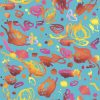The textile design industry is vast and evolving. Roles in the textile design industry blend creativity with technical, branding, and marketing skills and offer diverse career paths for those passionate about patterns, colors, fashion, and home decor textiles. While the textile design industry visually shapes the world around us, it can often be difficult to navigate and connect with those in the industry.
The Pattern Observer team is aiming to change this with a powerful new tool. The new Textile & Surface Pattern Design Directory helps connect designers, agents, clients, and suppliers globally, providing a comprehensive resource for those working with printed fabrics, and embroidery textile design.
Table of Contents:
A Deep Dive into the Textile Design Industry
The textile design industry encompasses more than just pretty patterns. It’s a complex process involving design principles, design development and collaboration, extensive research, production, and marketing.
Understanding the Design Process
Textile design starts with research. Designers immerse themselves in current trends, cultural influences, and their niche industries (fashion, home decor, paper, etc.) to spark new ideas. They explore color palettes, product design, and other innovative fabrics for inspiration.
Designers then move to the conceptualization phase. They define a specific artistic style, which is dictated by their own style or the style of their client’s brand. They then develop sketches, create hand-drawn designs, or use computer-aided design (CAD) software. Designers consider everything from color palettes to design texture, patterns, and the final product’s intended use.
Technical Skills and the Latest Trends
The textile design industry requires specific technical skills.
- Proficiency in software like Adobe Photoshop and Illustrator is often essential, but the emergence of design apps such as Procreate and free design software has opened up more opportunities for designers.
- There is a rising trend for agents and studios: requiring all pattern designs to be in repeat. Because of this, creating repeating patterns has become increasingly important. Pattern designers need to learn how to create high-quality repeats in less time, which will lead to an increase in sales and positive responses from agents, creative directors, and clients.
- Textile designers need to stay current on the latest trends and technological innovations. Buyers are looking for patterns that interpret the current print trends in a way that fits with the brand image of the company he or she represents. They are also looking for something unique to their company, something that their competitors won’t have. That’s why a designer’s interpretation of the latest trends is so important.

Career Paths in Textile Design
For textile and surface pattern designers, the textile design industry offers diverse career opportunities. Many choose the freelance route, collaborating with various brands on fashion textile design and design products.
Others find roles in fashion houses, interior design firms, or design studios. These studios might specialize in anything from technical textiles to fashion and interior applications, working to create unique designs.
| Career Path | Description |
|---|---|
| Freelance Textile Designer | Works independently on various projects for different clients, often creating patterns and exploring various knitting techniques. |
| Textile Designer in a Fashion House or Brand | Creates designs specifically for apparel and accessories, often working alongside a fashion designer to ensure designs effectively meet the brand’s vision. |
| Textile Designer in an Interior Design Firm or Home Decor Brand | Develops textiles for home furnishings and interior spaces, working with interior designers to create a cohesive aesthetic. |
| Textile Designer in a Design Studio | Focuses on specific design projects within the broader industry, covering niches like technical textiles or printed fabrics. Design involves applying design skills and design principles across a wide range of textile applications. |
Conclusion
The textile design industry is more than just creating beautiful fabrics. It’s a blend of art, technology, and innovation, constantly evolving with new trends emerging. Whether you are a seasoned professional or a recent graduate, promoting your work on a resource like Pattern Observer’s Textile & Surface Pattern Design Directory can be helpful to growing your network and seeking new opportunities.
As the industry changes, continuous learning is important. Participating in trade shows and fairs or joining design communities are beneficial. Learning more about design involves keeping up with design development, new trends and new manufacturing processes.
The textile design industry embraces innovation. This makes it an exciting career choice, whether your passion lies in intricate patterns, innovative fabrics, or working to create unique and beautiful design textile solutions.












